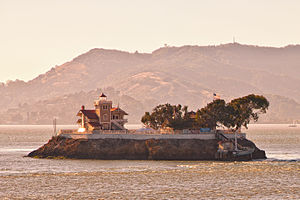East Brother Island Light

East Brother Island in 2012, with the light on the left.
|
|
|
California
|
|
| Location | East Brother Island San Pablo Bay San Francisco Bay Area California United States |
|---|---|
| Coordinates | 37°57′48″N 122°26′01″W / 37.963233°N 122.433643°WCoordinates: 37°57′48″N 122°26′01″W / 37.963233°N 122.433643°W |
| Year first constructed | 1874 |
| Automated | 1969 |
| Construction | woode tower |
| Tower shape | square tower with balcony and lantern attached to a 2-story keeper's house |
| Markings / pattern | ochre tower with white trim, red lantern |
| Height | 48 feet (15 m) |
| Focal height | 61 feet (19 m) |
| Original lens | Fourth order Fresnel lens |
| Current lens | FA 251 |
| Characteristic | Fl W 5s. |
| Fog signal | blast every 30s. |
| Admiralty number | G4215 |
| ARLHS number | USA-258 |
| USCG number | 6-5865 |
| Managing agent |
East Brother Light Station |
| Heritage | place listed on the National Register of Historic Places |
| Reference no. | 951 |
|
[]
|
|
East Brother Light Station
East Brother Island Lighthouse is a lighthouse located on East Brother Island in San Rafael Bay, near the tip of Point San Pablo in Richmond, California. It marks the entrance to San Pablo Bay from San Francisco Bay.
Built in 1874 and automated in 1969, the lighthouse was designed in the American Stick style by Paul J. Pelz, who also designed East Brother Island's sister stations,Point Fermin Light in San Pedro CA, Mare Island Light, in Carquinez Strait, California (demolished in the 1930s), Point Hueneme Light in California (replaced in 1940), Hereford Inlet Light in North Wildwood, New Jersey, and Point Adams Light in Washington State (burned down by the Lighthouse Service in 1912), all in essentially the same style. The former keeper's house began operating as a bed and breakfast in 1980.
Although the U.S. government recognized the need for a light to mark the area, mainland property was not available at a reasonable price. Instead the government turned its attention to the island, which it already owned. Large-scale blasting leveled the island off, and the two-story keeper's house was built with the attached tower and a fog signal building. The lamp was first lit on March 1, 1874.
The light tower is attached to keeper’s house, a two-story Victorian placed on a blasted away 1-acre (0.40 ha) rock. There was an assistant keeper’s house, equipment building, cistern, and water tank. The water cistern was blasted to a depth of 30 feet (9.1 m) and is capable of holding 50,000 US gallons (190 m3) of rain water.
Two of the most notable lighthouse keepers were John Stenmark and Willard Miller, each of whom logged twenty years of service, more than any other keepers. Originally from Sweden, Stenmark joined the lighthouse service at age twenty and distinguished himself for bravery during a boating accident. He was eventually appointed keeper at East Brother in 1894, and he lived at the station with his wife and four children. Miller began his tenure at East Brother in 1922. During his service the light was upgraded to a fixed, fifth-order Fresnel lens, powered by a 500-watt bulb. The steam fog signal was also converted to a compressor-driven diaphone. A serious accident on March 4, 1940 resulted in a fire that destroyed the island's wharf and boathouse along with four boats.
...
Wikipedia

